Marco Etheridge's Blog, page 9
October 15, 2018
Northwest Greek Odyssey - Korfu Two
 Korfu Fauna
Korfu FaunaTime has passed, and I have been waylaid by the perils of attempting to publish the newest novel. Apologies all around. It is a case of life on life's terms. But regardless, i cannot leave us stranded in Korfu, as much as that is a pleasant thought. So, through the miracle of blog time travel, we find ourselves still on the Greek island of Korfu.
We boarded the bus for Kavos, with the intent of hiking on the southern tip of Korfu. Kavos is the last stop on the Green Line, the bus that serves most of the island. Kavos is also party-central for the mainly young, mostly British folks who holiday here.
Stepping off the bus was like stepping onto one of the party streets on Koh Lanta, or Phuket, in Thailand, except the signs were in English. Open-air bars lined the streets, shuttered and quiet against the late morning. Rental scooters and quads motored about, bearing dread-locked folks looking worse for the wear. There was no doubt, this was party town.
After a quick coffee, we turned our backs to the strip and walked out of town under the heat of a brilliant sun. We were heading for the trails on the southern tip of the island, a few kilometers past Kavos.
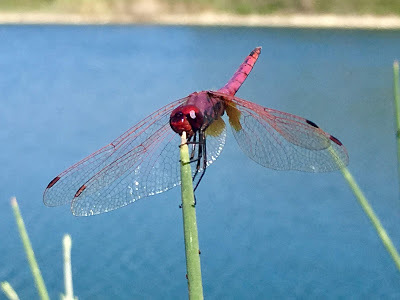 Fierce Flyer
Fierce FlyerAt the start, the hiking proved to be more of a game of dodge-the-quad. We were walking a narrow, rocky road, climbing the hills outside of town. Every few minutes, a rental quad sped past, heading for the secret beach. We knew the beach was secret because a very large sign, complete with arrow, proclaimed it to be so. I suppose the word has gotten out. We found a quieter trail an turned away. Once again, stepping off the beaten (and dusty) path brought the reward of a return to the quiet Greek countryside. We climbed through olive groves, glad for the shade and peace.
Korfu is a strange place. At first glance, it is a tourist enclave, an island overrun with folks seeking beach time and sunshine, sunsets and late-night cocktails. But wander up onto the rugged spine of the island, or the quieter west side, and Korfu is an island of rugged scenery and quiet villages. The southern town of Lefkimi, the ferry port for point south, offers a refuge from the bustle of Korfu town. To venture off the beaten path in Korfu requires only a small effort, and offers profound rewards.
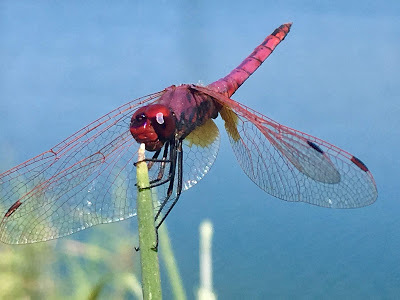 Shining Eyes
Shining EyesReaping the rewards of the path less traveled, we climbed about on the hills that make up the southern tip of the island. The trail dipped down into a large open bowl of land. Nestled between the hills was a lovely little lake. Alarmed at our approach, frogs shot from the grassy banks, plopping into the water. Fish meandered through the shallows, and turtles surfaced and dove. A bright magenta damselfly decided to ham it up for me, striking a brilliant pose.
 Korfu Idyll
Korfu IdyllSweating through our clothes, we whiled away the afternoon until it was time to catch the bus back up the coast. There was grilled octopus for dinner, and cigars on our perfect balcony. We watched the planes descending to the Corfu Town airport, bringing in the next loads of tourists. On the morrow we would be taking the ferry back to the Greek Mainland.
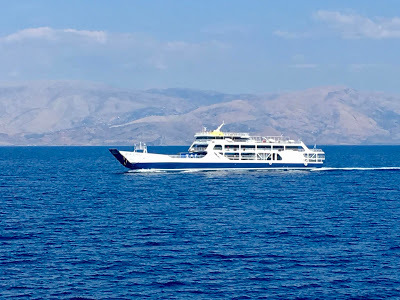 Ferry and the Albanian Hills
Ferry and the Albanian HillsIt was another hot day in Corfu Town. The piles of rubbish were still stacked around every dumpster. We retraced our steps from San Marcos square to the New Port, there to await our ferry to Igoumenitsa. The sun was shining on the water as the fortifications of the old city slid away. The brown hills of the Albanian coast stood sentinel against the blue sky and the still bluer sea. I think I could ride the ferry back and forth, back and forth, and be happy. I do so love to travel by boat; the slow, stately progress, the thrumming of the engines, the sea birds diving across the wake.
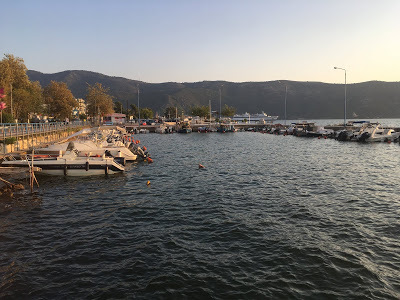 Igoumenitsa at the Gloaming
Igoumenitsa at the Gloaming Uncertainty about the possibility of ongoing buses left us in Igoumenitsa for the night, with hopes of a journey into the mountains the following day. We would travel back to Ioannina and attempt to catch the mysterious bus up into the small villages of Zagori. All that I could learn of the bus schedule to these remote villages was culled from reports on the internet. At the bus station, the man behind the glass sold us tickets to Ioannina, but could tell us nothing of any way to get north from there. It was the usual shrug-shrug, lift-of-the-hands: "A bus, yes, we have heard of such an invention. Possibly one goes to Zagori, but, shrug-shrug, I have no knowledge of such a thing."
Such is the way of it, venturing off the main routes. I don't believe the man-behind-the-glass meant to be unhelpful, though it certainly felt that way. The local folks we met were, as a rule, extremely friendly and helpful. It was not unlike India, where the the folks least likely to be friendly or helpful were, for the most part, wearing uniforms, and sitting at a counter behind a glass partition. So it goes.
So it was a hot and sweaty walk to find digs for the night, a cool shower to wash the day away, and a sunset evening in which to explore this small port town. But that is the stuff of the next post.
From the west coast of Greece, be kind, travel well, travel often, and Ciao for Now!
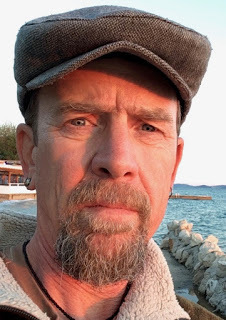 Marco
MarcoMarco Etheridge is the author of two published novels, The Best Dark Rain, and Blood Rust Chains.His third novel, a romantic thriller set in Vienna and other exotic locales, is pending publication. For more on Marco's work, go to his website at:
Marco Etheridge Fiction
Published on October 15, 2018 05:38
October 7, 2018
Northwest Greek Odyssey - Korfu
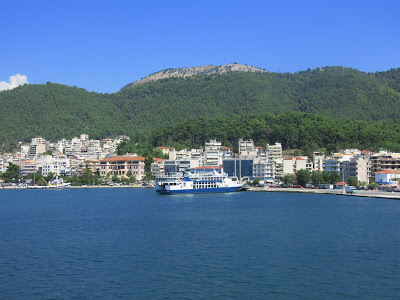 Igoumenitsa and Ferry
Igoumenitsa and FerryWe left Ioannina via bus, dropping down steadily from the highlands to the coast of the Adriatic Sea. Stopping in the busy little port town of Igoumenitsa, we boarded a ferry for Korfu. Or Corfu. Or...
The day was hot, the sun bright, a perfect day for a ferry ride. The boat slid out of the port, passing rocky, sun-drenched shores. As we moved into the open water beyond the harbor, the rugged mountains of Albania came into view to starboard. Dead ahead lay the island of Korfu, its undulating spine a dusky green against the vivid blue of the sea. I do love traveling by boat.
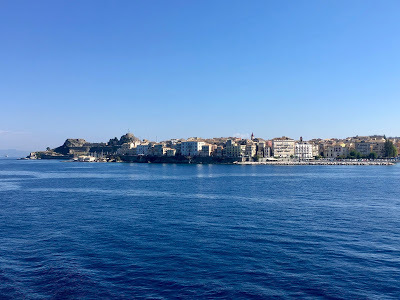 Κέρκυρα, Kérkyra, Korfu, Corfu: Take your pick
Κέρκυρα, Kérkyra, Korfu, Corfu: Take your pickKorfu is a place from ancient history, from the Peloponnesian Wars, a great naval power along with Athens and Corinth. There were pirates, Ottomans, Venetians, battles upon battles. The British took control following the Napoleonic Wars, finally ceding the place to what would become modern Greece.
Today, Corfu (Korfu for us folks from a German-speaking region) is one of the busiest tourist destinations in the Greek Islands. It is one of the closest islands to Europe, and is served by direct flights from European mainland, as well as the UK. Even in the shoulder season, Korfu is chock-full of tourists intent on getting in a lot of sun, and a lot of partying.
The ferries dock at the New Port, just outside the fortified Old City. Corfu Town was once one of the most fortified places in the Mediterranean, a testament to its violent past. Our digs were further down the coast, on the east side of the island. To get there, we had to walk through town to the San Marcos square, then catch a city bus down the coast.
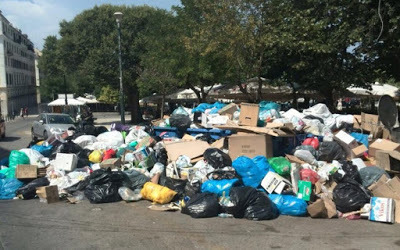 Korfu Rubbish Piles - Politics meets Landfill
Korfu Rubbish Piles - Politics meets LandfillThe first mystery of Corfu presented itself immediately. There were piles of rubbish everywhere. Every dumpster was accompanied by a huge pile rubbish, bags and boxes of it. Were the garbage collectors on strike? The scene repeated itself down the coast, with roadside dumpsters almost invisible under a small mountains of trash.
The key to the mystery lies in the political upheaval in Greece. The short answer to the trash piles is that the landfill on Kérkyra is full, plain and simple. The rest of the answer is a bit more complicated. The EU, trying to help out the struggling government, made a grant of Euros to build a proper new landfill. The Corfu folks will tell you, if you ask, that the local government then pocketed the money. Instead of building an approved landfill, they tried to open an unapproved landfill down south near Kavos, the main area for the British party crowd. There were protests, police in riot gear, and damaging headlines in the UK papers. As it stands, the piles of trash remain uncollected.
The subject of pirates has come up more than once in our travels. There is a new 'special' tax on tourist accommodations, fifty cents (Euro) per night, per person. Our hosts generally apologized for this, explaining that they were forced to collect the fee, and that they believed the money went straight into the pockets of the officials collecting it. I do not know the truth of any of this, except that we had to pay the tax. For the locals, times are hard here in Greece. The economic struggles of the Greek nation are well-documented by many sources far more knowledgeable than I. For my part, what I heard were tales of low wages, high prices, and rising taxes to cover the national debt and the flight of capital out of the country.
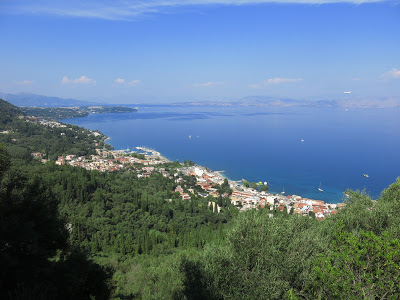 Benitses, Korfu - The Strip
Benitses, Korfu - The StripThe coast of Korfu is dotted with resort towns at regular intervals. Wherever there is a bit of level ground, or a bit of beach, there is a resort. Where the level bits are bigger, there are resort towns. Our spot was Benitses, a smallish town about forty minutes by bus from Corfu Town. Only venture a little way inland, however, and one will find a very different island.
Corfu is a bit schizophrenic, at least to my eyes. There is the coast, and then there is everything else. Running up and down the rugged spine of Corfu is the Corfu Trail. Winding back and forth through quiet villages and forested hillsides, the Corfu Trail is 220 kilometers long. While there a certainly hikers that come here to walk the trail, I would say the vast majority of tourists do not know the trail exists.
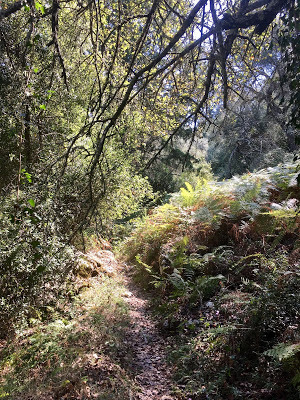 The Other Korfu
The Other KorfuOur evening was spent along the busy beach strip, eating grilled octopus and watching the party folks gear up for another night of revelry. Before they could get into full swing, we were back at our digs, enjoying the warm night from the privacy of our balcony.
The next day found us following a hand-drawn map, supplied by our host, which purported to lead us up the rough hillsides to the spine of the island, and the Corfu Trail. After just a few hundred meters, the bustle of the coastal strip fell away. We climbed in the hot sun, under wild olives and junipers. As if with a wave of a magic wand, we were suddenly back in Greece proper.
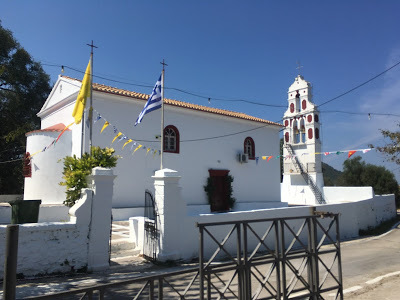 Village Church, Corfu Trail
Village Church, Corfu TrailThe map proved true, leading us to trail signs that pointed up, always up. We climbed away, the blue Adriatic shimmering below us. The steep, green ridges climbed above us. Lizards skittered across the trail, song birds flitted through the shadows, and the climb continued.
Hot and sweaty, we broke out onto the top of the main ridge and into a quiet sun-drenched village. We were now on the Corfu Trail itself, welcomed by the village cats.
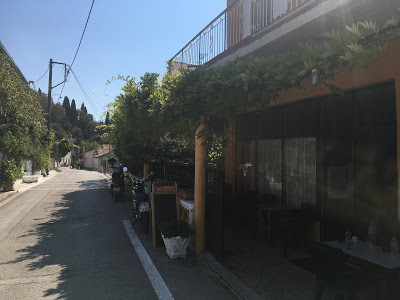 Village Traffic Jam
Village Traffic JamVoices and laughter led us to a café, which we were happy to take advantage of. Thick Greek coffee, a shady table, all on a quiet village lane. What else does a wanderer need? We chatted with the locals, rested our tired dogs, and let the world take care of itself for a bit. Our travels across Greece had become a hiking journey. My Heart and I are both serious walkers, but we had not specifically planned this trip to be a hiking sojourn. Yet this is what it seems to have become, and we are not sorry for it.
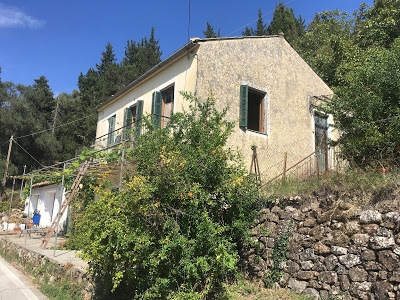 Rock Walls, Stone House
Rock Walls, Stone HouseLeaving our café behind, we wandered south, following the road which makes up this part of the trail. It is the sort of road that can be walked two abreast without fear of traffic. There simply isn't any. Our way led past stone houses, some still in use, some crumbing to rubble, some a combination of the two.
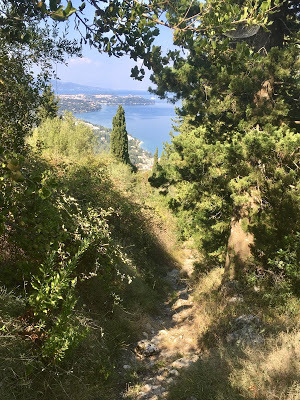 The Trail Back
The Trail BackWe walked as far as our legs would take us, letting the sun bake into us. With the advantage of the trail signs, we were able to find a new route back down the ridges to the coast. What can I tell you about hiking on a beautiful, hot day? There were rocky viewpoints, the welcome shadows of wild olives, the stony trail beneath our feet. It was altogether wonderful, and more so that we could hike directly out of town without resorting to any transport other than muscle power.
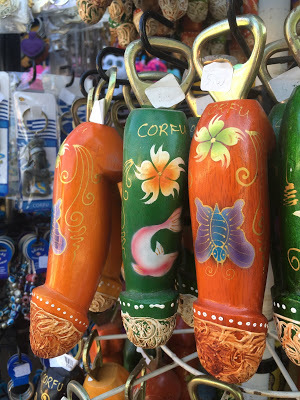 Classy Souvenirs
Classy SouvenirsThe souvenir shops and bars were right where we had left them, enticing the tourists out of their Euros. For today, it was Corfu Trail: 1, Beach: 0.
Published on October 07, 2018 11:39
September 30, 2018
Northwest Greek Odyssey -- Ioannina
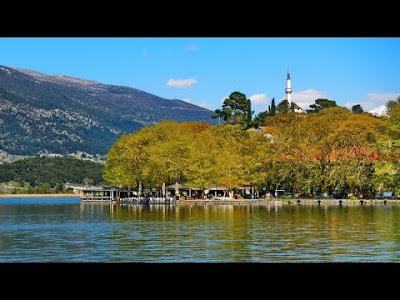 Ioannina, Greece
Ioannina, Greece Sometimes the guide books grant a favor to a poor traveler. Most of the time, it is a favor granted inadvertently. When some hugely popular guidebook series (not naming names, title has the initials LP) claims that this or that local city is "a transportation hub, not really worthy of an overnight stay..." reader take note. It is possible that the guidebook is correct, as is the case with Udon Thani. UT is a busy, dusty town in Isaan, the rural region of Northeast Thailand, and not much happening there. On the other hand, I have discovered some of my favorite small cities by making careful note of the phrase "Just another provincial city... blah blah blah."
"What in God's holy name are you blathering about?" Sorry. I'm blathering about our next destination, Ioannina, Greece. Yes, just a provincial city, set on a big lake, a transportation hub, most people give it a pass. Good for them, off they go, bye-bye.
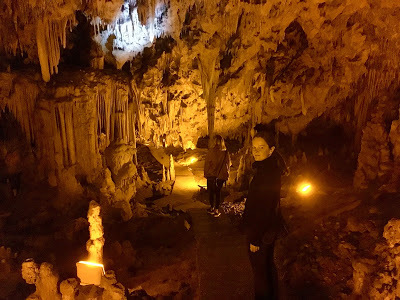 Parma Cave and a Cute Grrl
Parma Cave and a Cute GrrlWe had the grand countryside tour from Meteora to Ioannina. The bus wiggled and squiggled through back roads, climbed hairpins, and generally spent an hour aimed at taunting those prone to motion sickness. The slow first hour was followed by a quicker second hour, whizzing down the modern E90. The E90 is a unique highway in that it is almost entirely composed of tunnels and bridges. The bits of road that actually touch the ground are rare indeed. This is rugged and mountainous country, stark and scenic.
Deposited in the busy Ioannina bus station, we set off for the village of Parma, famous for the Parma Cave. The budget guesthouses were clustered around this village, so off we went. It was a short two kilometer walk, with full backpacks, and the afternoon Greek sun overhead. Have you noticed that almost everything is a 'short two kilometer walk?'
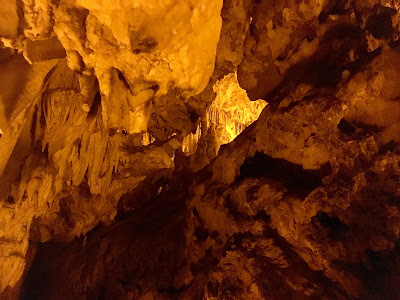 Parma Cave
Parma CaveParma was empty, a tourist town without tourists. This little village is a popular destination for Greek tourists looking for a weekend getaway. The big draw is Parma Cave. The cave was discovered by a young boy looking for a safe place to hide from aerial bombing during World War II. It has since been developed into a tourist attraction. The cave is well worth a tour. Being as there were no tourists in the village, we had our own private tour at no extra cost.
After a very quiet night in Parma, and a fabulous dinner at the one Taberna open for an evening meal, we let the day draw to a close, watching the over the quiet main street from out second-storey balcony. The following morning, after touring the cave, we took a city bus into Ioannina town.
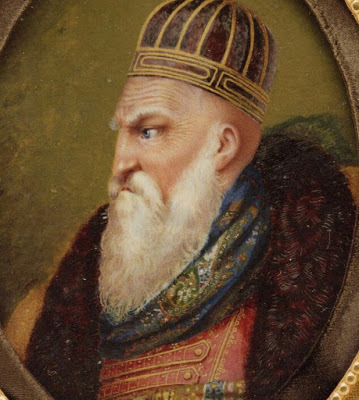 Ali Pasha, The Lion of Ioannina
Ali Pasha, The Lion of IoanninaIoannina is famous for being nestled against a large lake. Steep mountainsides rise from the green waters, making for a lovely vista. Crowded against the lake shore is the Ottoman-era palace and fortress of Ali Pasha. There were several Ali Pashas, it being an title of honour, but there is only one Lion of Ioannina, and he was a certified Bad-Ass.
The Lion started his career as the leader of a band of Albanian Brigands. After battling the Ottomans, he became one of them. Apparently being a leader of brigands was a fine job qualification in the empire. He was many, many things, but weak was not one of them. Ruthless, religiously tolerant, cunning, he ruled the Sanjak of Ioannina for more than three decades. About 1820, he ran afoul of the Sultan by conspiring to kill a member of the court, a member he had strong disagreements with. The Sultan was not pleased, eventually sending troops to Ioannina with instructions to return with Ali Pasha's head.
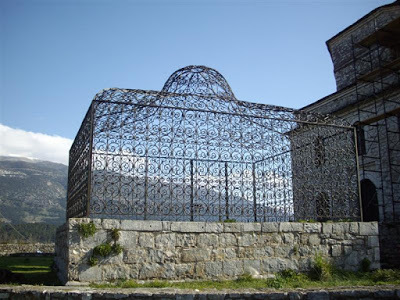 Ali Pasha's Grave, minus Head (photo: Ferhatbingol)
Ali Pasha's Grave, minus Head (photo: Ferhatbingol)Ali Pasha did his best to fight off the Sultan's invading army. He was about eighty years old by this time. Finally, his surviving loyal soldiers reduced to a small force, he was tricked into giving up his fortified palace. He removed himself to a monastery, hoping it to be a sanctuary. Such was not to be. The Sultan's forces closed in, surrounded him, and declared that he must surrender and meet his fate. He response is famous, at least in these parts: "My head will not be surrendered like the head of a slave!" With that, the Lion of Ioannina kept fighting. The Sultan's troops finally killed Ali Pasha by firing their muskets up through the floor of the room he occupied. Ali Pasha was dead at the age of eighty-two, fighting until the the end. His head was duly transported back to the Sultan in Constantinople. His body, sans head, lies in a grave in the palace compound.
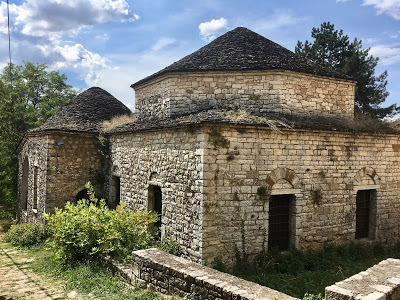 The Palace Complex, Old Town Ioannina
The Palace Complex, Old Town IoanninaIoannina is a fine walking town, flat, pretty, and lively. There are a few more tourists in the town itself, but it is mostly a stop for Greek travelers. The palace and old town are clustered around the shores of the lake, as is a fine lakeside promenade. Little boats ferry folks over to an island across the lake. The grid of the new town sits between the old town and the hills that rise away from the lake.
We had a fine time exploring the place, a good, simple walkabout. There were shopping lanes to poke about in, good eateries, and a very vibrant café scene. Ioannina is home to several colleges and schools, and boasts a large population of young students. They keep the place lively.
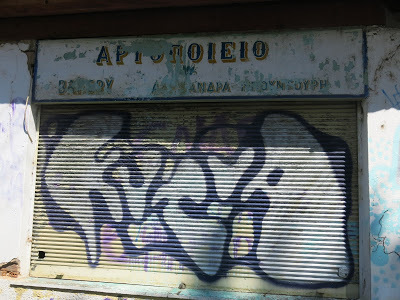 Old Bakery
Old BakeryThere is the usual grittiness that seems to go with larger Greek towns. Graffiti is a constant, running the gamut from political to street art. This is not some well-preserved UNESCO tourist ghetto, but rather a busy Greek town going about its business.
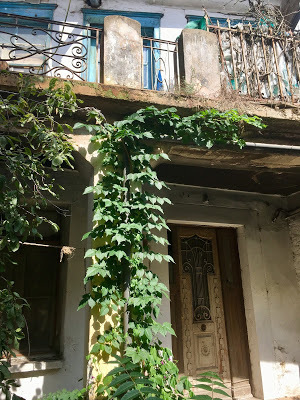 Ioannina Façade
Ioannina FaçadeThere are the buildings abandoned and lifeless alongside businesses that are flourishing. The mix is a good one, a sense of the past overlaid with the modern.
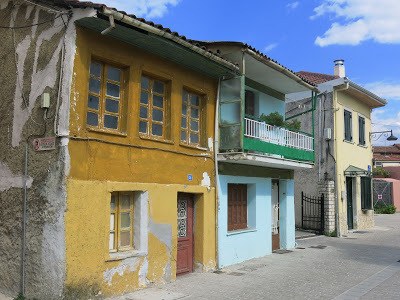 Backstreet, Ioannina
Backstreet, IoanninaIf you are looking for charming lanes devoid of traffic, wander toward the lake and disappear into the maze of the old walled city. Veer back out of the old city, and you will be engulfed in the shopping streets with their rows of competing cafés. Take your time, sit, have a coffee, watch the world walk by.
 Old Façade Resurrected
Old Façade ResurrectedIoannina does not have any "must-see" sights. It is what it is reported to be: a busy, provincial town. Look past that, however, and I think you will find a charming city that is certainly worth an overnight stay. We enjoyed two nights here without regret. This is one of those places that offers a solid cultural view. Sunning oneself on an island beach is a fine pastime, but spending two weeks on the beach does not mean I have seen Greece. It means I have seen the beach. Ioannina is a place to mingle with locals, talk to them, and get a sense of what the country is all about.
 Café Scene, Ioannina
Café Scene, IoanninaBy late afternoon we had found our café. This was one of the hipster spots, with great tunes, great coffee, and a great vibe. The locals were hanging out, greeting one another, and just generally kicking back. If I was to spend a month here, this would be my café. One of the lessons I have learned late in life is that it is very important to have a good café handy.
Speaking of islands, the next day would find us bound for Korfu, but that is the stuff of the next blog post. For this evening, it was a bus ride back to sleepy Parma, a second dinner at 'Our Joint,' and another quiet evening listening to the village folk talk away the night.
Published on September 30, 2018 12:09
September 29, 2018
Northwest Greek Odyssey -- Meteora
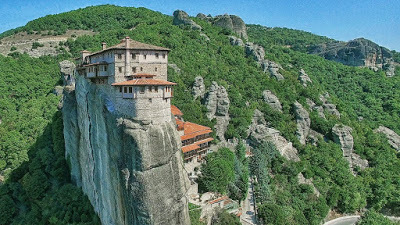 Meteora, Greece - Monasteries on the Rocks
Meteora, Greece - Monasteries on the RocksMeteora, Greece, home to the famous monasteries perched on impossible boulders. If you haven't heard of it, you have probably seen pictures of it. An image of Meteora graced an earlier edition of the Lonely Planet guide to Greece. Orthodox monks built the monasteries on top of these incredible rock pillars, for isolation as well as protection.
Even if you have not heard of Meteora, many, many other people have. It is one of the most visited sites in Northwestern Greece, a firmly established stop on the tour bus circuit. Ack! Tour Buses? Yes, tour buses, lots of them. But there is a secret that a smart visitor needs to know, or rather a few secrets. The first secret is fairly obvious: Don't be here in July or August. It is very hot, and very crowded. The second secret is that Meteora really isn't about the monasteries; it's all about the rocks. Tour bus folks do not like to hike, and Meteora is all about the hiking.
Many millions of years ago, this place was covered with stone and sand and mud, thick layers of it. About sixty million years ago, geological forces pushed lake bed and delta upwards, forming a plateau. Wind and water did their slow, inexorable work, and, Voilá! Crazy stone pillars.
The monasteries built atop these rock pillars are old, by modern standards. But human history in the Meteora area is far older. There is a cave not far from Kalambaka, the main town at Meteora, or "Clambake" as I like to refer to is. Anyway, the cave is called Theopetra, and it contains archeological records that go back to the time of the Neanderthals. How cool is that?
Two hours on the train, with one change, brought us to Kalambaka, or Clambake, a town nestled within easy boulder-bouncing range of the strange rock pillars. Let's just say I would not care to live on the north side of town. A very hot and sunny two-kilometer stroll brought us to our digs at the far edge of Kastraki, a smaller satellite village. The Meteora Gardens is funky and old, the campground closed, and the whole thing has a forlorn look. But the host was friendly and the budget room was cheery and cheap. Showered and restored, we set out to explore.
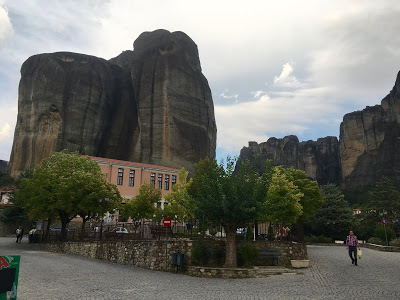 Kastraki Village Square
Kastraki Village SquareA short two kilometer walk up a quiet rural road brings one to the village center. Along the way there will be locals sitting on their porches, enjoying cool gloaming of the day. Remember to call out a cheery "YAh-soos" or "Kali-SPER-ah" and they will smile and wave. The second time you pass, they will remember you. It's a pretty friendly place. Kastraki has one of the coolest village squares ever, tucked between the church and school, and hemmed in by improbable rock pillars. It is a marvelous sight when the lamps twinkle on in the evening.
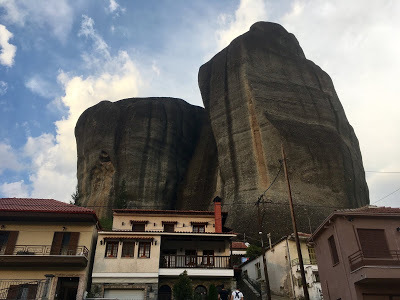
Kastraki Evening
We wandered about the tiny village, up and down steep lanes. Pillars of rock towered far above us. We settled on a fine little Taberna off the square and tucked into meal of homemade Moussaka, stuffed peppers and tomatoes, and, of course, Greek salad. We would need the calories, for tomorrow would be another day of steep hiking.
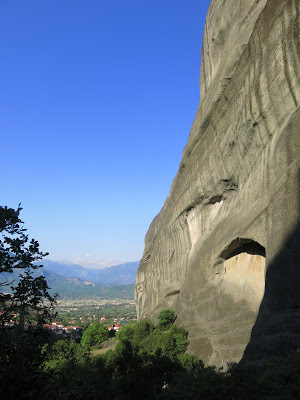
Morning Climb
The morning sun was blasting the sheer rock face above us as we climbed out of the sleepy village of Kastraki. A snarling dog warned us off the dead-end lane we had chosen, barking us toward the proper trail. The path wound its way up between two towers of rock. The dusky-green slot between the cliffs was no more than a hundred meters wide. Winding up and over boulders, under wild olive trees, the trail snaked to the top of the little pass. A rickety set of wooden stairs led up the rock face on our left, a midair climb to a hermitage caves or monastic ruin.
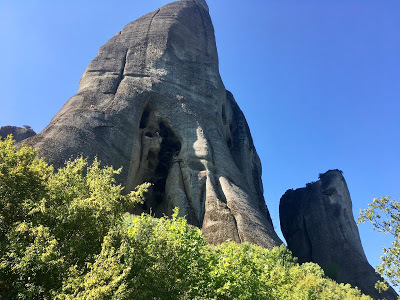
It's really about the Rock
We paused at the top of the tiny pass, dangling our legs off of a natural stone bench. The valley below us was ringed with fantasy towers of wind and water carved stone. Here and there, red-tiled roofs projected from the top of a stone pinnacle, one of the famous monasteries. The light had that Mediterranean crystal sharpness, etching each shadow, spotlighting each sun-drenched rock. All was peace. Then we heard the voices.
Voices rolling down from above? Were the ghosts of long-dead monks communing with us? But wait, the voices were speaking Deutsch. After following the sounds, and squinting in the sun, we finally spotted the two rock climbers on the face above us. If you zoom in on the photo above, you can see them as well. They are the two little dots on the left shoulder, below and to the left of the dominant crack. Looking at the surface of the rock, I decided better them than me. My serious rock days are over, but I never much liked conglomerate rock. Give me a nice granite or basalt any old time.
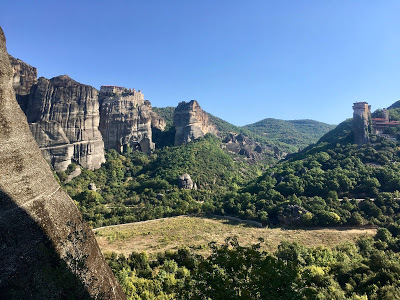
Into the Valley
There we sat on our little rock shelf, looking down into the valley. The view in the above photo is exactly what we were looking at. Monastery Roussanou is on the narrow pinnacle at the upper right. Monastery Varlamm is the larger monastery on the far upper left. Our plan was to hike across the valley, climb to Roussanou, then circle the upper draw to Varlamm. So we planned out route an set off.
There was a bit of route-finding, a few twists and turns, but eventually we crossed the road on the far side of the valley and began scrambling up the steep hill to Roussanou. As we reached the base of the rock pinnacle, we broke out into, well, bedlam. Cars, minivans, tour buses; we were in Important Tourist Sight Land.
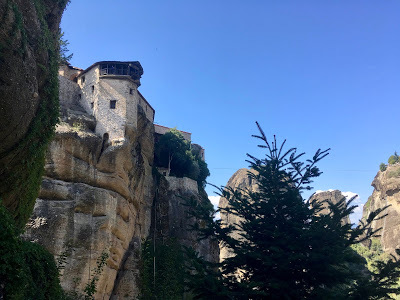
Oh look! A Monastery!
So: Here is the obligatory bit. The monasteries are pretty cool. When viewed from below they are impressive, when viewed across a fine valley they are sublime. Up close and personal, after walking past two dozen idling tour buses, twenty-five minivans, and ninety-two rental cars, whatever monastery you are approaching loses some of its appeal. There is a scrum to get into the monastery, a long queue that leads up flights of sun-drenched stone stairs. There are a great many people, many of whom avoid sun-drenched stone stairs like they avoid the Black Death. There are individual scrummers, and then there are the tour-scrummers. The tour-group herds will trample you like water buffalo if they think they have been separated from their group.
So, grit your teeth, chant "Important Sight, Important Sight..." under your breath. Climb the stairs, one slow, agonizing, step at a time. Pay the very reasonable three Euros to get in, then watch your Sweetie have a grumpy fit because she has to tie a loaner skirt over her full length hiking pants. The monks you know, just a glimpse of a woman in pants and, well, you know.....
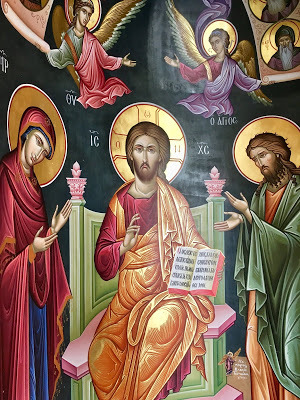
Grumpy Ikons
We bit the tourist bullet and toured Varlamm Monastery. We toured it like troopers, heads held high, taking in the important, the artistic. I made careful note of the grumpy faces portrayed in the Ikons. Really, really grumpy faces. I suppose they had a right to be grumpy. All those folks taking selfies from the parapets of the monastery walls, ignoring the reasons that the monastery existed. And, admittedly, I was and am being judgemental. Mea Culpa, Mea Culpa.
On the backside of the monastery, away from the selfie views, is a covered timber platform. Supplies are hoisted up from far below, and this platform serves as the landing pad. This arrangement offered the monks a way to resist the Turks and their pesky Ottoman occupation. It afforded us an excellent vantage point into the secluded valley below us, and to the trail that wound down into the enclosed valley.
So we fled. We fled like giggling children, dodging down the stairs, my Sweetie flinging her loaner skirt back onto the stack of tawdry loaner skirts. We eluded the throngs, disappeared down garden steps, and found ourselves on the very trail we were seeking. The way led down into a deep hollow, a circular valley that was almost completely enclosed by sheer rock walls. Only the narrowest of gaps allowed a slanting sun into the shadowed space.
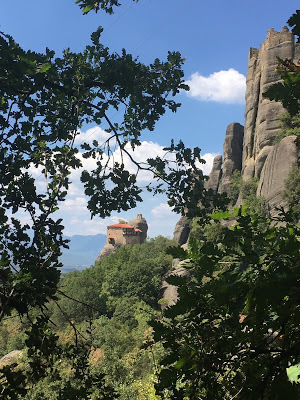
Obligatory Artsy Photo
The rest of the day was spent happily avoiding monasteries. We scrambled over rocks to avoid them, climbed through fantastic gaps to avoid them, boulder hopped to avoid them. If we saw a monastery trying to sneak up on us, we ran the other way, even if the way led up dodgy goat paths to narrow rock slots overlooking the town of Kalambaka.
There seem to be two distinct dangers to Meteora. One is the monasteries themselves. The second danger is that of getting a crick in ones neck from peering up at amazing rock formations while trying to hike a tiny trail.
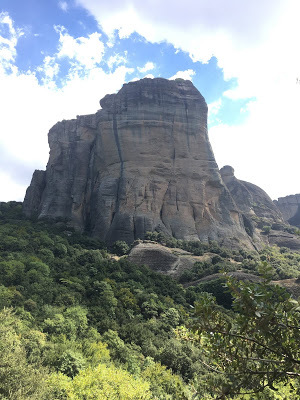
Back to Cool Rocks!!
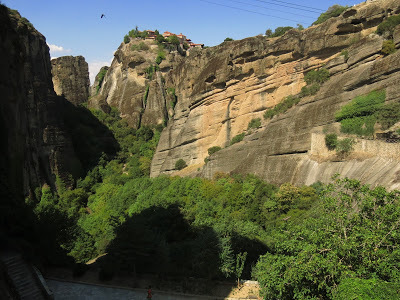
"Yeah, yeah, up through that slot, I see the route!"
By the end of the afternoon, we just started inventing our own hiking routes. The photo above is a good example. We set out from the spot below and managed to get through that little slot in the upper left of the photo. The path was mostly imaginary, but we passed through the slot, descending to the outskirts of Kalambaka and a welcome café.
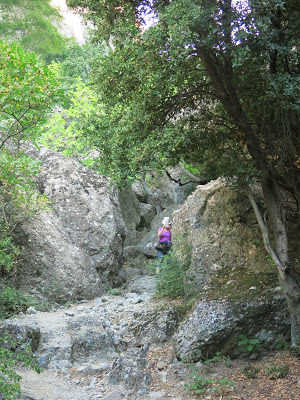
Climbing the gaps
My One, showing the goats how its done.
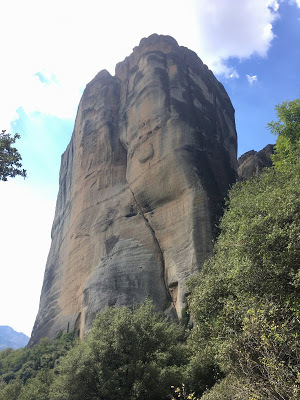
"Monasteries, sure, but check out that rock!"
So, in the end, it was as I said, at least for us. Meteora is all about the rocks. Sure, go see the monasteries. Go early in the day, or go late in the afternoon. Try to avoid the late morning or early afternoon. Enjoy the monasteries, poke around, have fun. But don't miss out on the real joy of this region.
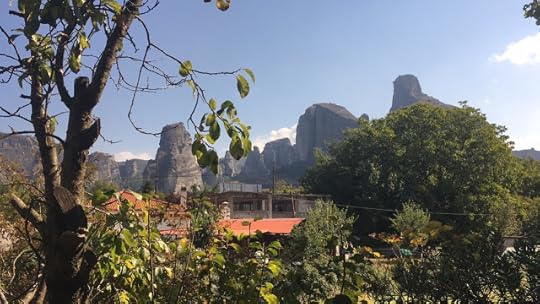
The View from the Smoking Room
There was sweat, there was resting, there were cafés and apres-hiking snacks. I enjoyed a lovey cigar and the fine view from our budget-balcony. It was yet another excellent day of hiking on a trip that seemed more and more devoted to hiking. There would be travel on the morrow, but there was the quiet evening to enjoy, and enjoy it we did.
Published on September 29, 2018 00:30
September 26, 2018
Northwest Greek Odyssey -- Litochoro
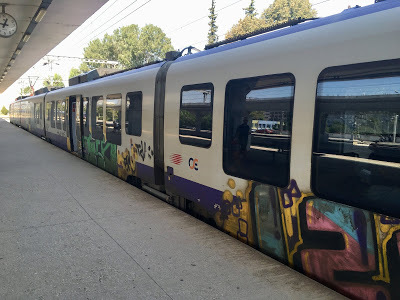 The Graffito TrenoLeaving a city by train often offers a non-scenic perspective, and Thessaloniki was no different. Train tracks tend to run past the warty parts of town, the stuff better hidden away from view; literally the wrong side of the tracks. Rolling west and south over the flat, coastal plains, we saw sidings full of rusted rolling stock; passenger cars that would never again carry passengers. Piles of junk and wind-swept loading docks pushed up against the tall plumes of coastal reeds. The train swept past derelict ruins of stone buildings, graffiti-coated to the height of tagger's reach. Then we were out of the city, stopping at each small village on the milk run south.
The Graffito TrenoLeaving a city by train often offers a non-scenic perspective, and Thessaloniki was no different. Train tracks tend to run past the warty parts of town, the stuff better hidden away from view; literally the wrong side of the tracks. Rolling west and south over the flat, coastal plains, we saw sidings full of rusted rolling stock; passenger cars that would never again carry passengers. Piles of junk and wind-swept loading docks pushed up against the tall plumes of coastal reeds. The train swept past derelict ruins of stone buildings, graffiti-coated to the height of tagger's reach. Then we were out of the city, stopping at each small village on the milk run south. Behind us, sitting amongst a crowd of bundles, an African guy engaged the conductor in a game of endurance. When the conductor asked for his ticket, he could not produce one. Though I could not understand the language of the exchange, it was clear that he was claiming he had no money. In the tired voice of someone who has heard it all before, the conductor was telling the African man that he must get off. This scene was repeated several times over the course of several villages. The man managed stay on the train until he reached his destination. Street theater on the train, and the performance did not cost me a dime.
Our destination was Litochoro, a small village at the foot of a canyon that leads to the high peaks of Mount Olympus. A bit more than an hour on the train and we would be at the gateway to the fabled mountain, the home of the vengeful and capricious Greek gods, gods who took the time to meddle in the affairs of mere mortals. And, as we were to find out, gods who still had time to meddle in our own paltry affairs.
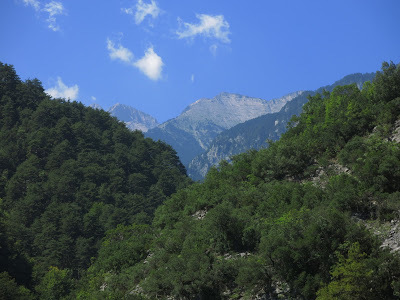 Mount Olympus
Mount OlympusAt each village stop, the small coastal towns had been clustered around the train station. What could be easier? We would hop off the train, have a short walk, and find our lodgings. Simple, no? No. When we arrived at the Litochoro station, we found ourselves standing on an empty platform. To the south were wind-flecked waves shimmering on the Aegean Sea. Turning to the north, we were treated to a sun-drenched view of green hills, the mouth of the canyon, and, far on the horizon, the summit of Mount Olympus. One thing, however, was missing. There was no village, at least not clustered snugly around the train station.
Baking under a hot afternoon sun, the land sloped up from the station, rising steadily to meet the green walls of the mountains. About ten kilometers away, tucked neatly against the sharp rise of the mountains, we could see a cluster of red-tiled roofs. Oops. We entered the station and inquired. Yes, Litochoro was up on the hill. There was a bus stop, yes, about two kilometers away. Maybe there would be a bus (shrug-shrug) but it is Sunday. Well then, this is why we have rucksacks.
We plodded out into the heat of the day, not a shred of shade, and not a taxi in sight. Under the hot afternoon sun, with fully loaded packs, two kilometers is just about enough of a walk to have one sweating right though the straps on said rucksack. After a good bit of walking, we spied a very empty and very forlorn bus stop. It looked as if it was last used about a decade ago. Score one for the Greek gods, the giggling bastards. But we were saved by the sight of a taxi. The driver was booked, but he was happy to call another driver from town.
I admit, on my best days, I am inherently distrustful of taxi drivers. Like all preconceived notions, it is an unfair bias, but I have it nonetheless. A taxi driver rescued me from an insane monsoon in Saigon, and all at a fair, metered price. Bangkok hacks are clean and fair, unlike the three-wheeled pirates that pilot the Tuk-tuks. But I digress. Our driver showed up, cheerful and smiling. Dimitrios (Jim) Daviotis loaded us into his Mercedes, cranked up the air-con, and whisked us into the charming village of Litochoro. Along the way he informed us of hiking routes, the wonders of the mountain, and all of the various tour services he could provide for us. A very fair nine Euros for the fare, and a Euro tip, left Dimitrios smiling and ourselves at one of the most charming guesthouses I have seen in a long time.
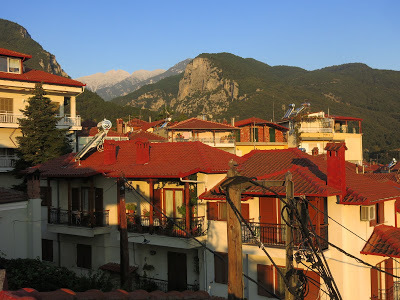 We Score the Great DigsGuesthouse Papanikolaou is just off a tiny lane that twists up out of the center of the village of Litochoro. It is the sort of guesthouse that travelers dream of finding, and remember fondly. Our lovely host greeted us, then led us to the top floor. The charming room opened onto a wide rooftop terrace with a stunning view of the mountains. One could not ask for more.
We Score the Great DigsGuesthouse Papanikolaou is just off a tiny lane that twists up out of the center of the village of Litochoro. It is the sort of guesthouse that travelers dream of finding, and remember fondly. Our lovely host greeted us, then led us to the top floor. The charming room opened onto a wide rooftop terrace with a stunning view of the mountains. One could not ask for more.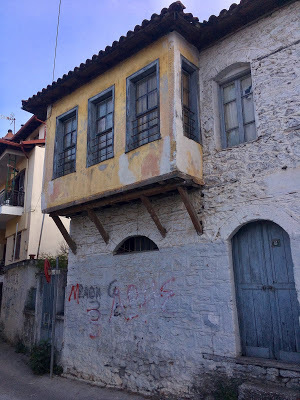 Village FaçadeLitochoro is a popular destination for weekend tourists, many of them Greek folks looking for a bit of cooler weather. The town was busy with the last of the weekend's travelers, lounging in the cafés and haunting the shops. One block off the main street and all of the tourist bustle dies away. We toured the town on foot, settled for an early dinner of pizza, then retired to our terrace to watch the sunset.
Village FaçadeLitochoro is a popular destination for weekend tourists, many of them Greek folks looking for a bit of cooler weather. The town was busy with the last of the weekend's travelers, lounging in the cafés and haunting the shops. One block off the main street and all of the tourist bustle dies away. We toured the town on foot, settled for an early dinner of pizza, then retired to our terrace to watch the sunset. 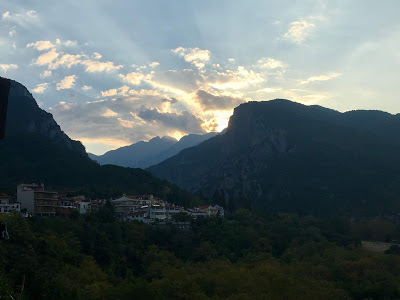 Sunset on Olympus
Sunset on Olympus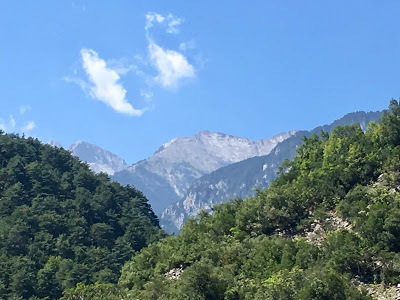 Heading for the Home of the GodsThe next morning found us climbing out of town, and into the narrow canyon that leads to the summit of Mount Olympus. The Greek gods were in no danger of being disturbed, at least not by us. Mount Olympus is 2,918 meters high (9,573 ft) and is a hard two-day climb from the village. The very highest peak, Mytikas, would remain unsullied by our mortal feet. Our goal was to go as far up the canyon as our desire, water, and food would take us.
Heading for the Home of the GodsThe next morning found us climbing out of town, and into the narrow canyon that leads to the summit of Mount Olympus. The Greek gods were in no danger of being disturbed, at least not by us. Mount Olympus is 2,918 meters high (9,573 ft) and is a hard two-day climb from the village. The very highest peak, Mytikas, would remain unsullied by our mortal feet. Our goal was to go as far up the canyon as our desire, water, and food would take us. 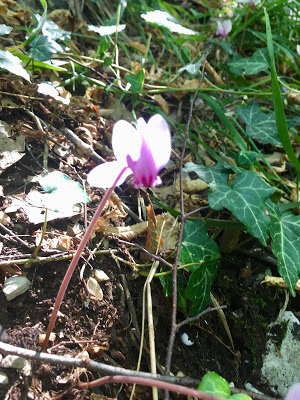 Carpeting the Forest Floor
Carpeting the Forest FloorThe rocky trail gets right to the business of climbing and sticks with it. The gorge fell away below us, narrowing to a slot canyon cut into fantastic rock formations. Where trees shaded the trail, the forest floor was decorated with delicate pink wildflowers. The fuscia-shaped blossoms pushed up through the green ivy and white stones, an idyllic carpet for the cool shadows. We climbed, dropped down, climbed again, the gorge falling farther below us as the trail hugged the steep walls of the canyon. The climbing turned seriously steep at a long set of switchbacks which were, of course, awash in the bright sunlight.
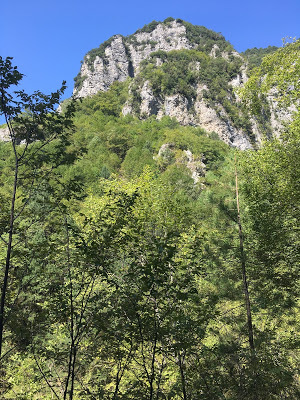 Bright Sun on Stone RampartsIt was hot hiking, hard hiking, and very rewarding hiking. We climbed in and out of the shadows, over the rough rocks, and through wonderful (and short) sections of smooth, shaded trail. Rock walls rose above us in the crystalline air. Glimpses of the slot canyon came into view below our tired feet. It was glorious.
Bright Sun on Stone RampartsIt was hot hiking, hard hiking, and very rewarding hiking. We climbed in and out of the shadows, over the rough rocks, and through wonderful (and short) sections of smooth, shaded trail. Rock walls rose above us in the crystalline air. Glimpses of the slot canyon came into view below our tired feet. It was glorious. 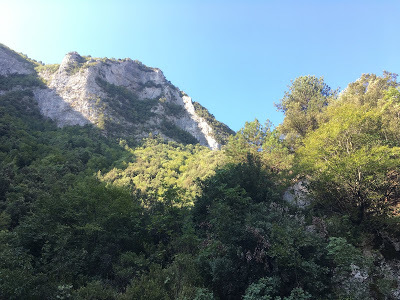 Sun and ShadowsThere were respites from the heat, sheltered rock faces still holding the cool of the morning. For just a moment, there was a feeling like someone had just opened a refrigerator door, a wave of coolness, and then the return of the sun and the force of the heat.
Sun and ShadowsThere were respites from the heat, sheltered rock faces still holding the cool of the morning. For just a moment, there was a feeling like someone had just opened a refrigerator door, a wave of coolness, and then the return of the sun and the force of the heat.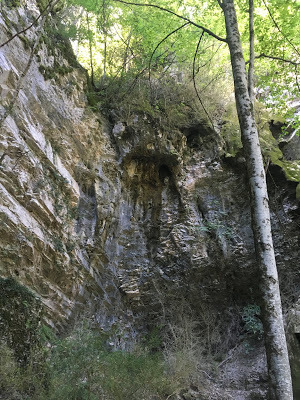 Shadowed GrottoHours into the climb we were getting tired, looking for that special place, something to justify calling it a day. It could be a viewpoint, or a shady rock, whatever the trail had to offer. There is always the pull to go to the end of the next rise, the next viewpoint, but it was time to find our spot.
Shadowed GrottoHours into the climb we were getting tired, looking for that special place, something to justify calling it a day. It could be a viewpoint, or a shady rock, whatever the trail had to offer. There is always the pull to go to the end of the next rise, the next viewpoint, but it was time to find our spot.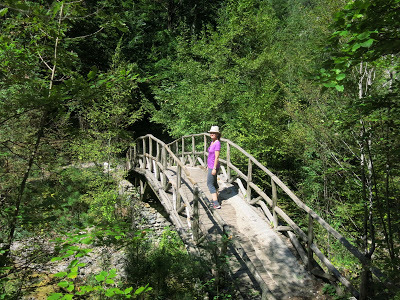 The Turn Around BridgeOur turn around proved to be a rickety bridge over a small creek, a cool and shady place with a lovely view. There was even a stone bench next to a stone fountain basin. The fountain had long since ceased to function, but it was a welcome seat nonetheless.
The Turn Around BridgeOur turn around proved to be a rickety bridge over a small creek, a cool and shady place with a lovely view. There was even a stone bench next to a stone fountain basin. The fountain had long since ceased to function, but it was a welcome seat nonetheless.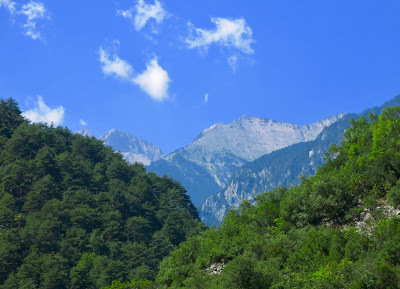 Mount Olympus, Still Far AwayOur legs and feet were voting resoundingly for a turnaround. Three and a half hours up and there was still the climb down. Time to make a whole new set of muscles do their work. There were excellent views of the mountaintop, but we did not see Zeus throwing thunderbolts or Hera throwing fits.
Mount Olympus, Still Far AwayOur legs and feet were voting resoundingly for a turnaround. Three and a half hours up and there was still the climb down. Time to make a whole new set of muscles do their work. There were excellent views of the mountaintop, but we did not see Zeus throwing thunderbolts or Hera throwing fits.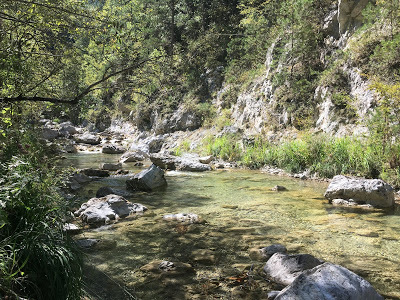 A Cool Afternoon Freshet
A Cool Afternoon FreshetHalfway back, we found a trail slanting down a scree field. It would mean climbing back up again, but the thought of a cool break along the river was too much of a temptation. We dropped down into the canyon and enjoyed a long sit along the river. We perched ourselves on some rocks along the clear water, content to watch the river run. There was a small army of frogs clustered amongst the rocks and ferns. We watched them hunting bugs and cheered them on when one of the froggies made a successful leap. The afternoon light was moving on and eventually so were we. Back up the scree field we climbed.
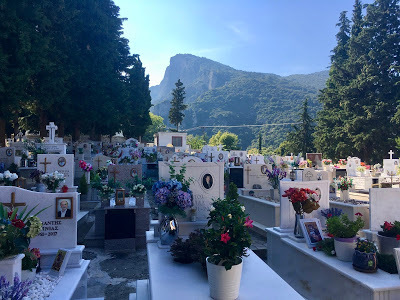 Orthodox Cemetery in the GloamingWe left the trail behind, stepping out onto the road that leads down into the village. At the very edge of the hamlet sits an Orthodox Cemetery. Who can resist a well-kept cemetery at the gloaming of the day? The tombs are all raised above ground, most topped with clean, white gravel. The headstones are adorned with photos of the dearly departed, and tiny oil lamps burn at the foot of most of the graves.
Orthodox Cemetery in the GloamingWe left the trail behind, stepping out onto the road that leads down into the village. At the very edge of the hamlet sits an Orthodox Cemetery. Who can resist a well-kept cemetery at the gloaming of the day? The tombs are all raised above ground, most topped with clean, white gravel. The headstones are adorned with photos of the dearly departed, and tiny oil lamps burn at the foot of most of the graves. 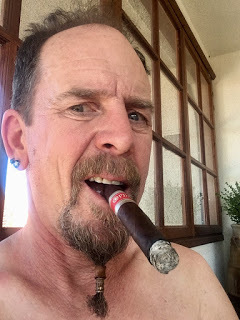 A Well-Earned Cigar
A Well-Earned CigarFinally back at the digs, after almost seven hours on the trail, it was time for a cigar on the terrace. Showering and dinner would come afterwards. It was a sublime hike, hard, sweaty, and rewarding.
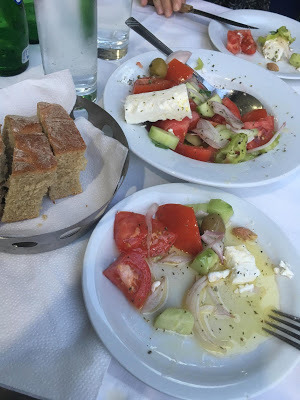 Greek Salads for Everyone!!Cleaned up and hungry, we set out through the small lanes of town above our guesthouse. The evening was cool and wonderful, the food was great, and the begging cats were reasonably well-behaved.
Greek Salads for Everyone!!Cleaned up and hungry, we set out through the small lanes of town above our guesthouse. The evening was cool and wonderful, the food was great, and the begging cats were reasonably well-behaved. Litochoro had proved to be a fantastic choice for our first small village. The town is picturesque, the scenery is wonderful, and the hiking was challenging and beautiful. Tomorrow would bring another train journey to yet another hiking destination. The rest of our evening was dedicated to romance on our perfect rooftop terrace, watched over by the Greek gods from their lofty perch.
Published on September 26, 2018 10:10
Northwest Greek Odessey -- Litochoro
 The Graffito Treno
The Graffito TrenoLeaving a city by train often offers a non-scenic perspective, and Thessaloniki was no different. Train tracks tend to run past the warty parts of town, the stuff better hidden away from view; literally the wrong side of the tracks. Rolling west and south over the flat, coastal plains, we saw sidings full of rusted rolling stock; passenger cars that would never again carry passengers. Piles of junk and wind-swept loading docks pushed up against the tall plumes of coastal reeds. The train swept past derelict ruins of stone buildings, graffiti-coated to the height of tagger's reach. Then we were out of the city, stopping at each small village on the milk run south.
Behind us, sitting amongst a crowd of bundles, an African guy engaged the conductor in a game of endurance. When the conductor asked for his ticket, he could not produce one. Though I could not understand the language of the exchange, it was clear that he was claiming he had no money. In the tired voice of someone who has heard it all before, the conductor was telling the African man that he must get off. This scene was repeated several times over the course of several villages. The man managed stay on the train until he reached his destination. Street theater on the train, and the performance did not cost me a dime.
Our destination was Litochoro, a small village at the foot of a canyon that leads to the high peaks of Mount Olympus. A bit more than an hour on the train and we would be at the gateway to the fabled mountain, the home of the vengeful and capricious Greek gods, gods who took the time to meddle in the affairs of mere mortals. And, as we were to find out, gods who still had time to meddle in our own paltry affairs.
 Mount Olympus
Mount OlympusAt each village stop, the small coastal towns had been clustered around the train station. What could be easier? We would hop off the train, have a short walk, and find our lodgings. Simple, no? No. When we arrived at the Litochoro station, we found ourselves standing on an empty platform. To the south were wind-flecked waves shimmering on the Aegean Sea. Turning to the north, we were treated to a sun-drenched view of green hills, the mouth of the canyon, and, far on the horizon, the summit of Mount Olympus. One thing, however, was missing. There was no village, at least not clustered snugly around the train station.
Baking under a hot afternoon sun, the land sloped up from the station, rising steadily to meet the green walls of the mountains. About ten kilometers away, tucked neatly against the sharp rise of the mountains, we could see a cluster of red-tiled roofs. Oops. We entered the station and inquired. Yes, Litochoro was up on the hill. There was a bus stop, yes, about two kilometers away. Maybe there would be a bus (shrug-shrug) but it is Sunday. Well then, this is why we have rucksacks.
We plodded out into the heat of the day, not a shred of shade, and not a taxi in sight. Under the hot afternoon sun, with fully loaded packs, two kilometers is just about enough of a walk to have one sweating right though the straps on said rucksack. After a good bit of walking, we spied a very empty and very forlorn bus stop. It looked as if it was last used about a decade ago. Score one for the Greek gods, the giggling bastards. But we were saved by the sight of a taxi. The driver was booked, but he was happy to call another driver from town.
I admit, on my best days, I am inherently distrustful of taxi drivers. Like all preconceived notions, it is an unfair bias, but I have it nonetheless. A taxi driver rescued me from an insane monsoon in Saigon, and all at a fair, metered price. Bangkok hacks are clean and fair, unlike the three-wheeled pirates that pilot the Tuk-tuks. But I digress. Our driver showed up, cheerful and smiling. Dimitrios (Jim) Daviotis loaded us into his Mercedes, cranked up the air-con, and whisked us into the charming village of Litochoro. Along the way he informed us of hiking routes, the wonders of the mountain, and all of the various tour services he could provide for us. A very fair nine Euros for the fare, and a Euro tip, left Dimitrios smiling and ourselves at one of the most charming guesthouses I have seen in a long time.
 We Score the Great Digs
We Score the Great DigsGuesthouse Papanikolaou is just off a tiny lane that twists up out of the center of the village of Litochoro. It is the sort of guesthouse that travelers dream of finding, and remember fondly. Our lovely host greeted us, then led us to the top floor. The charming room opened onto a wide rooftop terrace with a stunning view of the mountains. One could not ask for more.
 Village Façade
Village FaçadeLitochoro is a popular destination for weekend tourists, many of them Greek folks looking for a bit of cooler weather. The town was busy with the last of the weekend's travelers, lounging in the cafés and haunting the shops. One block off the main street and all of the tourist bustle dies away. We toured the town on foot, settled for an early dinner of pizza, then retired to our terrace to watch the sunset.
 Sunset on Olympus
Sunset on Olympus
Heading for the Home of the Gods
The next morning found us climbing out of town, and into the narrow canyon that leads to the summit of Mount Olympus. The Greek gods were in no danger of being disturbed, at least not by us. Mount Olympus is 2,918 meters high (9,573 ft) and is a hard two-day climb from the village. The very highest peak, Mytikas, would remain unsullied by our mortal feet. Our goal was to go as far up the canyon as our desire, water, and food would take us.
 Carpeting the Forest Floor
Carpeting the Forest FloorThe rocky trail gets right to the business of climbing and sticks with it. The gorge fell away below us, narrowing to a slot canyon cut into fantastic rock formations. Where trees shaded the trail, the forest floor was decorated with delicate pink wildflowers. The fuscia-shaped blossoms pushed up through the green ivy and white stones, an idyllic carpet for the cool shadows. We climbed, dropped down, climbed again, the gorge falling farther below us as the trail hugged the steep walls of the canyon. The climbing turned seriously steep at a long set of switchbacks which were, of course, awash in the bright sunlight.
 Bright Sun on Stone Ramparts
Bright Sun on Stone RampartsIt was hot hiking, hard hiking, and very rewarding hiking. We climbed in and out of the shadows, over the rough rocks, and through wonderful (and short) sections of smooth, shaded trail. Rock walls rose above us in the crystalline air. Glimpses of the slot canyon came into view below our tired feet. It was glorious.
 Sun and Shadows
Sun and ShadowsThere were respites from the heat, sheltered rock faces still holding the cool of the morning. For just a moment, there was a feeling like someone had just opened a refrigerator door, a wave of coolness, and then the return of the sun and the force of the heat.
 Shadowed Grotto
Shadowed GrottoHours into the climb we were getting tired, looking for that special place, something to justify calling it a day. It could be a viewpoint, or a shady rock, whatever the trail had to offer. There is always the pull to go to the end of the next rise, the next viewpoint, but it was time to find our spot.
 The Turn Around Bridge
The Turn Around BridgeOur turn around proved to be a rickety bridge over a small creek, a cool and shady place with a lovely view. There was even a stone bench next to a stone fountain basin. The fountain had long since ceased to function, but it was a welcome seat nonetheless.
 Mount Olympus, Still Far Away
Mount Olympus, Still Far AwayOur legs and feet were voting resoundingly for a turnaround. Three and a half hours up and there was still the climb down. Time to make a whole new set of muscles do their work. There were excellent views of the mountaintop, but we did not see Zeus throwing thunderbolts or Hera throwing fits.
 A Cool Afternoon Freshet
A Cool Afternoon FreshetHalfway back, we found a trail slanting down a scree field. It would mean climbing back up again, but the thought of a cool break along the river was too much of a temptation. We dropped down into the canyon and enjoyed a long sit along the river. We perched ourselves on some rocks along the clear water, content to watch the river run. There was a small army of frogs clustered amongst the rocks and ferns. We watched them hunting bugs and cheered them on when one of the froggies made a successful leap. The afternoon light was moving on and eventually so were we. Back up the scree field we climbed.
 Orthodox Cemetery in the Gloaming
Orthodox Cemetery in the GloamingWe left the trail behind, stepping out onto the road that leads down into the village. At the very edge of the hamlet sits an Orthodox Cemetery. Who can resist a well-kept cemetery at the gloaming of the day? The tombs are all raised above ground, most topped with clean, white gravel. The headstones are adorned with photos of the dearly departed, and tiny oil lamps burn at the foot of most of the graves.

A Well-Earned Cigar
Finally back at the digs, after almost seven hours on the trail, it was time for a cigar on the terrace. Showering and dinner would come afterwards. It was a sublime hike, hard, sweaty, and rewarding.

Greek Salads for Everyone!!
Cleaned up and hungry, we set out through the small lanes of town above our guesthouse. The evening was cool and wonderful, the food was great, and the begging cats were reasonably well-behaved.
Litochoro had proved to be a fantastic choice for our first small village. The town is picturesque, the scenery is wonderful, and the hiking was challenging and beautiful. Tomorrow would bring another train journey to yet another hiking destination. The rest of our evening was dedicated to romance on our perfect rooftop terrace, watched over by the Greek gods from their lofty perch.
Published on September 26, 2018 10:10
September 25, 2018
Northwest Greek Odyssey -- Thessaloniki
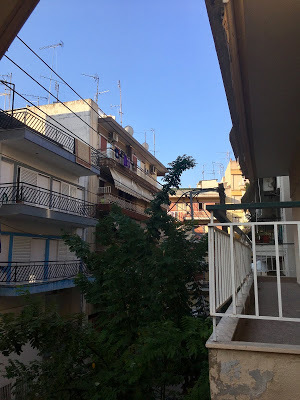 The view from our balcony
The view from our balconyI had just returned from the USA, an almost four-week journey filled with friends and family. My time in the states was full of the joys of friendship, and of seeing my son. It was also punctuated with sadness at the pervasive sense of anger and division I felt in my former home. After but a few days back in Vienna, it was time to repack the faithful Deuter backpack for a new journey, a trip to Northwestern Greece. My Heart had remained in Vienna whilst I was in the USA, and she was yearning to travel. And so we set out. It was a short ride on the miraculous Vienna public transit system to the airport, and a short flight to Thessaloniki, the second largest city in Greece.
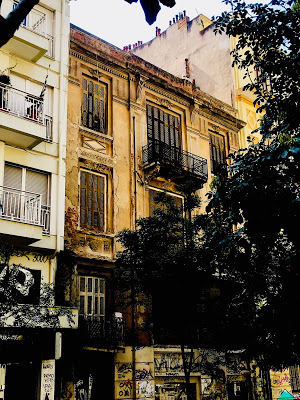 Thessaloniki FaçadeThessaloniki sits on the Northwest corner of the Aegean Sea, at the end of the Thermaic Gulf. It is a vibrant city, busy and bustling. Thessaloniki reminds me of Napoli, my favorite city in Italy. It is vibrant, lively, and worn hard around the edges. Thessaloniki is a modern city laid over a tangle of history that dates back to the Byzantine Empire, when it was the co-capital of the Eastern Roman Empire. The history of the city is much older than that, as is the case with most Mediterranean towns. Founded in 315 BCE by the Macedonians, Thessaloniki has been host to the usual cast of characters down through the epochs. The Romans followed the Macedonians, then the Byzantine Empire, Crusaders and the Latin Empire, then the Ottomans. The more modern history of the city is a complicated affair, including the early Balkan Wars, two World Wars, and the Greek Revolution. The city has a diverse religious history as well. Paganism, Orthodox Christianity, Christian Zealots, Judaism, and Islam have all flourished here.
Thessaloniki FaçadeThessaloniki sits on the Northwest corner of the Aegean Sea, at the end of the Thermaic Gulf. It is a vibrant city, busy and bustling. Thessaloniki reminds me of Napoli, my favorite city in Italy. It is vibrant, lively, and worn hard around the edges. Thessaloniki is a modern city laid over a tangle of history that dates back to the Byzantine Empire, when it was the co-capital of the Eastern Roman Empire. The history of the city is much older than that, as is the case with most Mediterranean towns. Founded in 315 BCE by the Macedonians, Thessaloniki has been host to the usual cast of characters down through the epochs. The Romans followed the Macedonians, then the Byzantine Empire, Crusaders and the Latin Empire, then the Ottomans. The more modern history of the city is a complicated affair, including the early Balkan Wars, two World Wars, and the Greek Revolution. The city has a diverse religious history as well. Paganism, Orthodox Christianity, Christian Zealots, Judaism, and Islam have all flourished here.We made our way from the airport on a cramped city bus, standing up the entire way. Thessaloniki is a hot, sunny city. It is also a city that climbs the steep hills from the long port-side promenade. The bus deposited us in the center of the city, and we reconnoitered our route to our digs. Shouldering our rucksacks, we set out on our walk, climbing under a bright sky and hot afternoon sun. We walked, we climbed, we walked and climbed, until we were running with sweat. This is September, the shoulder season, when many of the tourist have departed. Yet it is still 32 Grad, or about 90 Fahrenheit. I cannot imagine why anyone would want to go to a Greek city in July or August, when the heat soars higher, and crowds of tourists are melting everywhere. Three-quarters of an hour of steep climbing brought us to Neapoli, a vibrant neighborhood far above the city where a pair of wandering travelers attract studied glances.
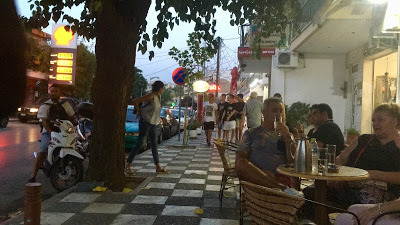 Vibrant Café NightlifeThe streets were quiet under the hot afternoon sun. The smart Greek folks were sitting in the shade of the many small cafés, drinking thick coffee. The soft click of worry beads could be heard at the tables occupied by groups of older men. If there was an Olympic event for best café sitters, I think it would be tough competition between the old guys from Italy, Turkey, and Greece. No self-respecting Greek business is complete without two or three men hanging out in front of the door. They sit at a rickety table in the shade, click their worry beads, and watch the world go by. A simple "YAH-soos" as we pass produces smiles and nods all around.
Vibrant Café NightlifeThe streets were quiet under the hot afternoon sun. The smart Greek folks were sitting in the shade of the many small cafés, drinking thick coffee. The soft click of worry beads could be heard at the tables occupied by groups of older men. If there was an Olympic event for best café sitters, I think it would be tough competition between the old guys from Italy, Turkey, and Greece. No self-respecting Greek business is complete without two or three men hanging out in front of the door. They sit at a rickety table in the shade, click their worry beads, and watch the world go by. A simple "YAH-soos" as we pass produces smiles and nods all around.Climbing a last hill up a small street, we found our digs and, after a bit of calling and searching, we found our host. Thessaloniki is proud of the hotels down on the promenade, the narrow flat part of the city. A traveler can expect to pay 100 Euros a night for a room. Up here, in the hills above the city, we found a spacious apartment for 50 Euros. That is the price of sweaty walk. A cool shower amended everything, followed by a well-earned cigar on the shady balcony. Refreshed and hungry, we were ready to sample what the evening had to offer.
When the sun goes down the streets come alive. A cool breeze off the Aegean Sea brings folks thronging to the cafés and eateries. It seems that no one wants to sit at home in a stuffy apartment when they can be sitting at a café or bar table. We tucked into a Gyros (pronounced "Gee-Ros") joint for some cheap eats. Dinner and drinks set us back seven Euro. Then it was off to a lovely sidewalk café for coffee; a long, slow, leisurely affair. It was street theater on a warm evening, and we the only foreigners in sight.
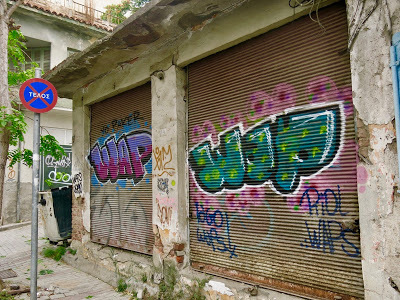 Street ArtMorning came hot and bright. One of my greatest joys in life is a walkabout in a new city. Thessaloniki is a great walking town, as long as one doesn't mind steep hills and hot weather. The hillsides above the narrow strip of the center are a tangle of crooked streets and lanes, each one climbing or falling as the cityscape dictates. We made out way down to the train station, inquired about trains for the next day, then set out across the long southeast strip of the main city. The promenade runs from the busy port at the northwest end of town out past the iconic White Tower at the southeastern end. One can walk along the water for a good bit more than two miles. During the heat of the day, there are a smattering of tourists, a few fishermen, and not much more.
Street ArtMorning came hot and bright. One of my greatest joys in life is a walkabout in a new city. Thessaloniki is a great walking town, as long as one doesn't mind steep hills and hot weather. The hillsides above the narrow strip of the center are a tangle of crooked streets and lanes, each one climbing or falling as the cityscape dictates. We made out way down to the train station, inquired about trains for the next day, then set out across the long southeast strip of the main city. The promenade runs from the busy port at the northwest end of town out past the iconic White Tower at the southeastern end. One can walk along the water for a good bit more than two miles. During the heat of the day, there are a smattering of tourists, a few fishermen, and not much more.Turn left, away from the water, you will find yourself amongst the storefronts and cafés that crowd the tight grid of streets. At intervals, there are several wide boulevards that lead away from the water and into the city itself. Some of these are lined with a mix of modern and period hotels. Others are the broad remnants of the imperial roads, leading to Byzantium ruins. Scattered amongst the grid of streets are squares with the squat stone rotundas of orthodox churches, some of which were transformed to mosques, and back again, as the empires changed.
Add frequent breaks for thick, sludgy Greek coffee, more pauses for fresh Greek salads, and the heat of the day becomes a very bearable presence. There are churches to explore, ruins to inspect, and plenty of museums for the culturally inclined.
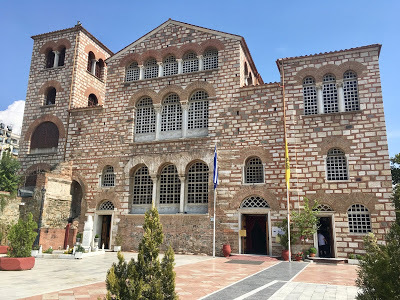 One of many churchesOne excellent way to cool off and soak up a bit of art and culture is a detour into one of the many Orthodox churches. The icons are worth the time spent, not to mention the shady coolness inside the stone sanctuaries. It is a good idea to be mindful that the churches are places of worship and the Orthodox folks are conservative. Tank tops and shorts are frowned upon.
One of many churchesOne excellent way to cool off and soak up a bit of art and culture is a detour into one of the many Orthodox churches. The icons are worth the time spent, not to mention the shady coolness inside the stone sanctuaries. It is a good idea to be mindful that the churches are places of worship and the Orthodox folks are conservative. Tank tops and shorts are frowned upon. 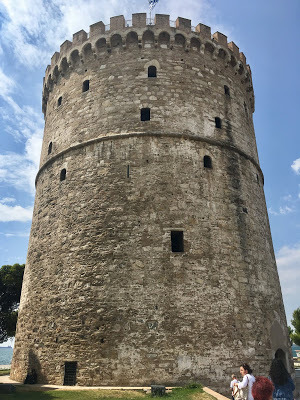 The iconic White TowerThe iconic White Tower rises where the seaside promenade doglegs to the south. The Ottomans built the existing tower upon the foundation of an even more ancient Byzantine fortification. During the Ottoman rule, the place served as protection for the harbor, as well as a prison and a place of execution for the unfortunates who ran afoul of the Sultan. Today, the tower serves as a nexus on the promenade. It is a busy evening gathering place to enjoy the evening breeze off the bay, let the children run wild, and just generally hang out.
The iconic White TowerThe iconic White Tower rises where the seaside promenade doglegs to the south. The Ottomans built the existing tower upon the foundation of an even more ancient Byzantine fortification. During the Ottoman rule, the place served as protection for the harbor, as well as a prison and a place of execution for the unfortunates who ran afoul of the Sultan. Today, the tower serves as a nexus on the promenade. It is a busy evening gathering place to enjoy the evening breeze off the bay, let the children run wild, and just generally hang out.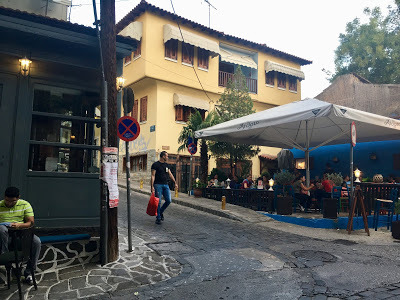 Neighborhood CafésA hard climb above the narrow strip along the sea will bring one to the remains of the city walls. There are some great little neighborhoods tucked above and below the walls, clinging to the steep hillsides. We discovered one such enclave on our way back to the apartment. The cool of the evening found us walking back down a section of the hill for our evening meal. It proved to be well worth the hike.
Neighborhood CafésA hard climb above the narrow strip along the sea will bring one to the remains of the city walls. There are some great little neighborhoods tucked above and below the walls, clinging to the steep hillsides. We discovered one such enclave on our way back to the apartment. The cool of the evening found us walking back down a section of the hill for our evening meal. It proved to be well worth the hike.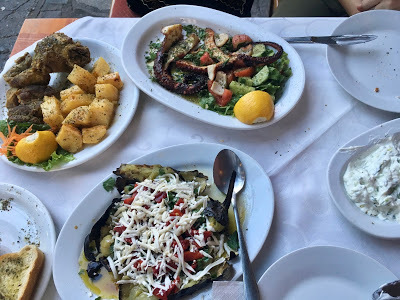 Splendid EatsWalking and climbing the city under the hot sun left us with some serious appetites. Our hosts did their best to satisfy. We indulged in the full Greek meal of starters, Greek salad, and main dishes. we dug into creamy, garlicky tzatziki, chewy bread, stuffed eggplant, grilled octopus, and roast lamb. All the while the local cats vied for tidbits. To dine out in Greece is to get used to street cats. Small sweets are almost always included at the end of the meal. Our total bill for this huge feast was 27 Euro.
Splendid EatsWalking and climbing the city under the hot sun left us with some serious appetites. Our hosts did their best to satisfy. We indulged in the full Greek meal of starters, Greek salad, and main dishes. we dug into creamy, garlicky tzatziki, chewy bread, stuffed eggplant, grilled octopus, and roast lamb. All the while the local cats vied for tidbits. To dine out in Greece is to get used to street cats. Small sweets are almost always included at the end of the meal. Our total bill for this huge feast was 27 Euro. 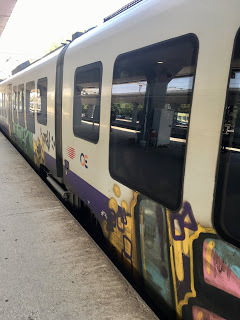 Graffito Train to the WestThe next day we enjoyed a leisurely morning of coffee and watching the world. Eventually, it was time to move on. We sweated our way, downhill this time, to the train station. Our next destination was southwest, along the coast, to the fabled slopes of Mount Olympus. I was glad that we would be returning to Thessaloniki for another night before our return flight. This was a great city with which to begin our travels in Northwestern Greece.
Graffito Train to the WestThe next day we enjoyed a leisurely morning of coffee and watching the world. Eventually, it was time to move on. We sweated our way, downhill this time, to the train station. Our next destination was southwest, along the coast, to the fabled slopes of Mount Olympus. I was glad that we would be returning to Thessaloniki for another night before our return flight. This was a great city with which to begin our travels in Northwestern Greece.
Published on September 25, 2018 06:09
Northwest Greek Oydessy -- Thessaloniki
 The view from our balcony
The view from our balconyI had just returned from the USA, an almost four-week journey filled with friends and family. My time in the states was full of the joys of friendship, and of seeing my son. It was also punctuated with sadness at the pervasive sense of anger and division I felt in my former home. After but a few days back in Vienna, it was time to repack the faithful Deuter backpack for a new journey, a trip to Northwestern Greece. My Heart had remained in Vienna whilst I was in the USA, and she was yearning to travel. And so we set out. It was a short ride on the miraculous Vienna public transit system to the airport, and a short flight to Thessaloniki, the second largest city in Greece.

Thessaloniki Façade
Thessaloniki sits on the Northwest corner of the Aegean Sea, at the end of the Thermaic Gulf. It is a vibrant city, busy and bustling. Thessaloniki reminds me of Napoli, my favorite city in Italy. It is vibrant, lively, and worn hard around the edges. Thessaloniki is a modern city laid over a tangle of history that dates back to the Byzantine Empire, when it was the co-capital of the Eastern Roman Empire. The history of the city is much older than that, as is the case with most Mediterranean towns. Founded in 315 BCE by the Macedonians, Thessaloniki has been host to the usual cast of characters down through the epochs. The Romans followed the Macedonians, then the Byzantine Empire, Crusaders and the Latin Empire, then the Ottomans. The more modern history of the city is a complicated affair, including the early Balkan Wars, two World Wars, and the Greek Revolution. The city has a diverse religious history as well. Paganism, Orthodox Christianity, Christian Zealots, Judaism, and Islam have all flourished here.
We made our way from the airport on a cramped city bus, standing up the entire way. Thessaloniki is a hot, sunny city. It is also a city that climbs the steep hills from the long port-side promenade. The bus deposited us in the center of the city, and we reconnoitered our route to our digs. Shouldering our rucksacks, we set out on our walk, climbing under a bright sky and hot afternoon sun. We walked, we climbed, we walked and climbed, until we were running with sweat. This is September, the shoulder season, when many of the tourist have departed. Yet it is still 32 Grad, or about 90 Fahrenheit. I cannot imagine why anyone would want to go to a Greek city in July or August, when the heat soars higher, and crowds of tourists are melting everywhere. Three-quarters of an hour of steep climbing brought us to Neapoli, a vibrant neighborhood far above the city where a pair of wandering travelers attract studied glances.
 Vibrant Café Nightlife
Vibrant Café NightlifeThe streets were quiet under the hot afternoon sun. The smart Greek folks were sitting in the shade of the many small cafés, drinking thick coffee. The soft click of worry beads could be heard at the tables occupied by groups of older men. If there was an Olympic event for best café sitters, I think it would be tough competition between the old guys from Italy, Turkey, and Greece. No self-respecting Greek business is complete without two or three men hanging out in front of the door. They sit at a rickety table in the shade, click their worry beads, and watch the world go by. A simple "YAH-soos" as we pass produces smiles and nods all around.
Climbing a last hill up a small street, we found our digs and, after a bit of calling and searching, we found our host. Thessaloniki is proud of the hotels down on the promenade, the narrow flat part of the city. A traveler can expect to pay 100 Euros a night for a room. Up here, in the hills above the city, we found a spacious apartment for 50 Euros. That is the price of sweaty walk. A cool shower amended everything, followed by a well-earned cigar on the shady balcony. Refreshed and hungry, we were ready to sample what the evening had to offer.
When the sun goes down the streets come alive. A cool breeze off the Aegean Sea brings folks thronging to the cafés and eateries. It seems that no one wants to sit at home in a stuffy apartment when they can be sitting at a café or bar table. We tucked into a Gyros (pronounced "Gee-Ros") joint for some cheap eats. Dinner and drinks set us back seven Euro. Then it was off to a lovely sidewalk café for coffee; a long, slow, leisurely affair. It was street theater on a warm evening, and we the only foreigners in sight.
 Street Art
Street ArtMorning came hot and bright. One of my greatest joys in life is a walkabout in a new city. Thessaloniki is a great walking town, as long as one doesn't mind steep hills and hot weather. The hillsides above the narrow strip of the center are a tangle of crooked streets and lanes, each one climbing or falling as the cityscape dictates. We made out way down to the train station, inquired about trains for the next day, then set out across the long southeast strip of the main city. The promenade runs from the busy port at the northwest end of town out past the iconic White Tower at the southeastern end. One can walk along the water for a good bit more than two miles. During the heat of the day, there are a smattering of tourists, a few fishermen, and not much more.
Turn left, away from the water, you will find yourself amongst the storefronts and cafés that crowd the tight grid of streets. At intervals, there are several wide boulevards that lead away from the water and into the city itself. Some of these are lined with a mix of modern and period hotels. Others are the broad remnants of the imperial roads, leading to Byzantium ruins. Scattered amongst the grid of streets are squares with the squat stone rotundas of orthodox churches, some of which were transformed to mosques, and back again, as the empires changed.
Add frequent breaks for thick, sludgy Greek coffee, more pauses for fresh Greek salads, and the heat of the day becomes a very bearable presence. There are churches to explore, ruins to inspect, and plenty of museums for the culturally inclined.
 One of many churches
One of many churchesOne excellent way to cool off and soak up a bit of art and culture is a detour into one of the many Orthodox churches. The icons are worth the time spent, not to mention the shady coolness inside the stone sanctuaries. It is a good idea to be mindful that the churches are places of worship and the Orthodox folks are conservative. Tank tops and shorts are frowned upon.
 The iconic White Tower
The iconic White TowerThe iconic White Tower rises where the seaside promenade doglegs to the south. The Ottomans built the existing tower upon the foundation of an even more ancient Byzantine fortification. During the Ottoman rule, the place served as protection for the harbor, as well as a prison and a place of execution for the unfortunates who ran afoul of the Sultan. Today, the tower serves as a nexus on the promenade. It is a busy evening gathering place to enjoy the evening breeze off the bay, let the children run wild, and just generally hang out.
 Neighborhood Cafés
Neighborhood CafésA hard climb above the narrow strip along the sea will bring one to the remains of the city walls. There are some great little neighborhoods tucked above and below the walls, clinging to the steep hillsides. We discovered one such enclave on our way back to the apartment. The cool of the evening found us walking back down a section of the hill for our evening meal. It proved to be well worth the hike.
 Splendid Eats
Splendid EatsWalking and climbing the city under the hot sun left us with some serious appetites. Our hosts did their best to satisfy. We indulged in the full Greek meal of starters, Greek salad, and main dishes. we dug into creamy, garlicky tzatziki, chewy bread, stuffed eggplant, grilled octopus, and roast lamb. All the while the local cats vied for tidbits. To dine out in Greece is to get used to street cats. Small sweets are almost always included at the end of the meal. Our total bill for this huge feast was 27 Euro.
 Graffito Train to the West
Graffito Train to the WestThe next day we enjoyed a leisurely morning of coffee and watching the world. Eventually, it was time to move on. We sweated our way, downhill this time, to the train station. Our next destination was southwest, along the coast, to the fabled slopes of Mount Olympus. I was glad that we would be returning to Thessaloniki for another night before our return flight. This was a great city with which to begin our travels in Northwestern Greece.
Published on September 25, 2018 06:09
July 23, 2018
Book reivew: Frank Herbert's "Dune"
 Dune by Frank Herbert
Dune by Frank HerbertMy rating: 5 of 5 stars
What can one say about Frank Herbert's "Dune," a pillar in the pantheon of Science Fiction? I have read this book several times in my life, beginning as a young man. Last week, I found myself thinking of some passage from the book, and so another reading began.
To read "Dune" is read several books, books within books. One of the reoccurring themes in the novel is the concept of feints within feints, motives underlying motives. I suppose it should come as not surprise, then, that there are many levels to this novel. On the surface, there is a tale of wild adventure, set in a complex feudal system flung far into the future. The inventions of our era have, in the distant past of this tale, wrought havoc, bringing about a new structure. Computers, 'Thinking Machines,' have been replaced by special beings trained in these functions. 'Atomics' are heirlooms of the great feudal families, not to be used on pain of planetary obliteration. The warfare of this era has become personal, a warfare of edged weapons and poison-wielding assassins.
This story of adventure is the first tale, the presenting story. Young Paul Atreides, heir to a Ducal fief, is cast into a whirling storm of intrigue, feudal struggle, and blood vendetta. This tale is enough to satisfy the reader, a story full of adventure, danger, and struggle. There are heroes and villains, the valiant and the cowardly, the good and the despicable. It is a rollicking saga.
The basic plot-line of the novel carries with it many deeper stories, stories that will reward the thoughtful reader. There are far greater forces at work in Paul Atreides life, forces that are outside of his control, forces put into play long before his birth. Frank Herbert explores the ideas of destiny, predetermination, and the struggles of a young man coming to terms with his destiny. Will he accept the mantel that has been crafted for him, crafted without his consent? Will he fling the mantel away, forging his own destiny? As the story progresses, the layers of destiny and treachery become ever deeper, entwining themselves into the myth of a hostile planet.
An arid and frightening world, the planet Arrakis becomes yet another layer to the novel, an ecological treatise on the nature of human beings and their environment. Using the interplay between characters and the harsh landscape they inhabit, the author weaves a story of the land altering the people, and the people altering the land. Is the environment a product of human action, or is the environment shaping the human action? Could it be both?
Beyond all of this lies the mystery of the nature of myth and religion, human engineering of myth, and the impact of that engineering on the future. The building wave of religion and myth carry the story to a crescendo, standing on the knife-edge of cataclysmic warfare.
Rereading Frank herbert's "Dune" was a pleasure. The novel contains everything a reader could want: sweeping adventure, love, parental bonds, loyalty, treachery, suspense, betrayal and revenge. The hero's journey is clearly mapped, convincing, and captivating. For the thoughtful reader, there is much more, a deeper examination of the nature of society, destiny, and religion. Never far from the thread of the tale is how human beings interact with the ecosystems they inhabit, changing them and being changed by them.
I highly recommend this novel. At the very least, the reader will be rewarded with an adventurous romp. Beneath the adventure lies a deeper examination of what forges destiny and purpose, religion and myth. I believe that many readers will be drawn back to this book, rereading it and treasuring it, as I have done.
View all my reviews
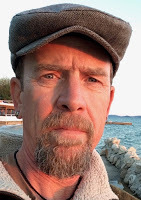
An ex-resident of Seattle, Marco Etheridge lives and writes in Vienna, Austria. When he isn’t creating great fiction or being a good Hausmann, he explores the world with his lovely wife. If the sun is shining too brightly, or the birds are too chipper, Marco studies German grammar to create a suitably dark mood for creativity. He is the author of two novels, The Best Dark Rain and Blood Rust Chains. Marco’s current projects include a children’s book and the first draft of his third novel, a political satire/thriller set in Europe.
Marco Etheridge Fiction
Published on July 23, 2018 03:50
July 20, 2018
A Small Slavic Circle
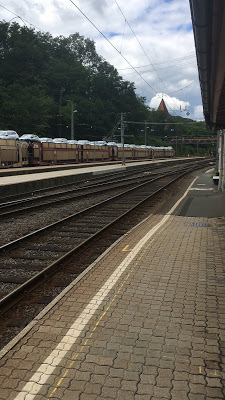 Life should not consist entirely of slaving away over the keyboard, banging out the next novel project. The fact that it does consist, almost entirely, of banging out the next novel project, gave me pause. So when my friend Gus gave me a plausible excuse, I jumped at it.
Life should not consist entirely of slaving away over the keyboard, banging out the next novel project. The fact that it does consist, almost entirely, of banging out the next novel project, gave me pause. So when my friend Gus gave me a plausible excuse, I jumped at it.A very old friend, this Gus character is a professor, raconteur, and photographer extraordinaire. After attending a high-brow photography workshop in Italy, he wanted to wander around a bit. There you have the entire incentive for a circle through Slovenia, Croatia, Hungary, and Slovakia.
Vienna to Ljubljana, €80 for the direct train or €29 for the somewhat more local train. Ever the starving author, you know which one I chose. And so it was a merry chase, four local trains across Austria and Slovenia, empty little border stations and stopping at every rural crossroads. It was great! Farms and fields, peaks and valleys, the world falling away into the rhythm of the slow train.
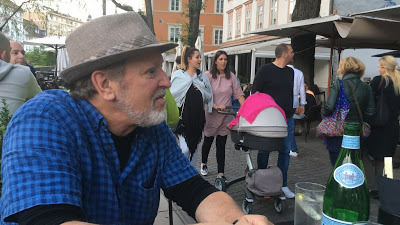
Professor Gus, Ljubljana
Ljubljana, the capital city of Slovenia, is also one of the funnest city names to say out loud. Try it a few times, see if you can come up with our loving nickname for the place. Vibrant, young, fun, and small enough to be very manageable, Ljubljana is a great spot. The city is a mix of modern Europe. Tito's Yugoslavia, and the Habsburg era. A river runs through it (sorry!) complete with picturesque stone bridges. Outdoor cafés line the river and, of course, there is the Tourist-Shopping-Street. Aside from the T-S-S, Ljubljana is a gem of a walking city.
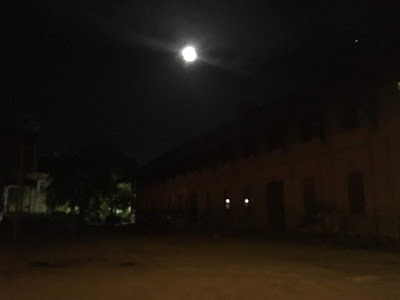
The moon it did rise low, My Love, As I walked through your town.
The silver moon rose low, My LoveAs I came walking down
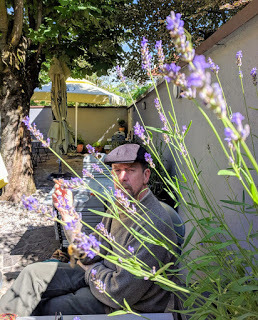
Me and a Bee, Ljubljana

The great thing about hanging out with artsy friends from the states is that they often have cool stuff, like a Rental Car! Oh, the luxury of turning up random roads, being a crappy navigator, and getting totally lost. Even better when one's traveling companion loves getting lost as much as you do.
We ran from dead-end to hidden shrine, taking quite possibly the slowest and wiggliest route between Ljubljana and Zagreb. One-lane roads over bumpy mountains covered with steep forests, picture-perfect little farms (which I have no pictures of) and coffee stops at remote cafés.
The Grand Slovenian Back-road Tour managed to transform a two-hour drive into a seven-hour drive. We finally wandered into Zagreb under dark clouds. If you have read any of my other travel posts, you will know that I love Zagreb. It took Gus about six hours to fall in love with the place.
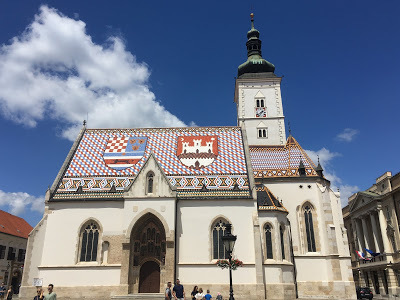
There are churches, of course.
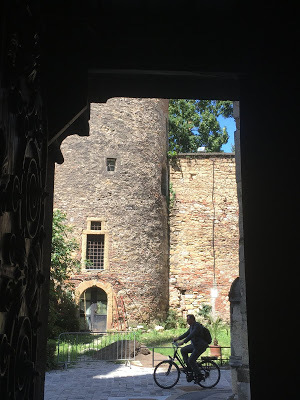
The medieval upper town is one of Zagreb's charms, but unlike Ljubljana, be prepared to hike up and down hills.
The oddest thing about being in Zagreb is that I used the city as one setting in my current novel project. I was seeing the place through the eyes of my characters, as well as through my own. And Gus, bless his heart, was getting a little sick of hearing about it.
I tried to make it up to him by leading him around one of my favorite cities without walking him to death. Instead, I walked him half to death, then we sat at a café and watched the world go by. After walking his second half to death, we found an outdoor dinner place. The rest of the evening was spent cheering for Croatia in the World Cup.
Go Checkered Devils!! (I continued to root for Croatia throughout the World Cup)

Wall Art, Zagreb (no, really, the wall is the art)
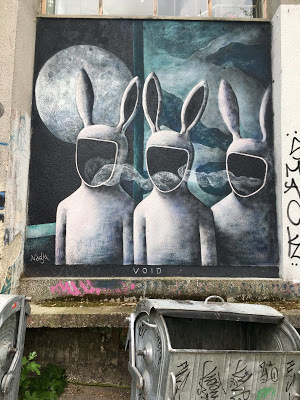
The Bunnies of Death -- Street Art, Zagreb
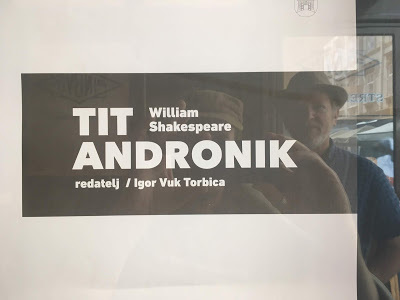
Two knuckleheads reflected in translation. It's always about the translation.
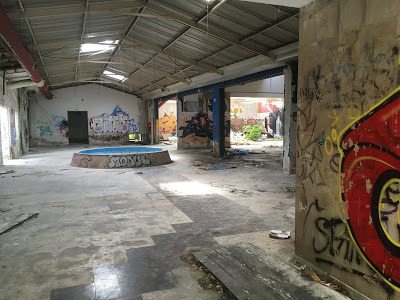 The Ruins of Disco -- Abandoned Diskotek, Zagreb
The Ruins of Disco -- Abandoned Diskotek, ZagrebThe circle ran on, out of Zagreb to the weirdness of a lake resort in Hungary, Lake Balaton. We just picked it off the map because it looked cool, a great whonking big lake. It turned out to be a strange time-warp, casting us back into a world of 1960's era family fishing vacations. And guess what? That is exactly what it is, verified by My Heart, who spent her childhood vacations there.
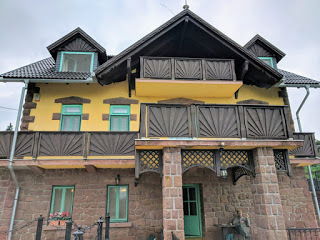 Lake Balaton -- Trapped in the weird villa, run by Attila
Lake Balaton -- Trapped in the weird villa, run by AttilaSo we left, driving through rain, then brilliant sun over massive fields of sunflowers. Gus kept threatening to pull over and cut off his ear. After managing to keep all the meaty bits attached, we finally wandered into Slovakia, and a whirlwind tour of Bratislava. Bratislava has done a fantastic job of marketing its small Old Town as a tourist destination. Ninety minutes from Vienna, Bratislava has started pulling in day-trippers, shuttled here from Wien by boat, bus, and rail. Even with the influx of tourists, it is an easy town to disappear into. Climb some of the steep hills, or venture out into the 'modern city' of the Tito-era, and the tourists are gone.
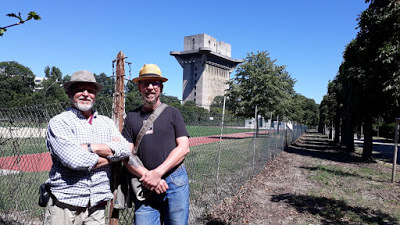
Poseurs -- Flak Tower, Vienna
The Professor had to fly back over the pond, so time was running out. A few nights in Wien, showing him my favorite odd places, then he was gone. Alas! Alas! will be the cry, when the lovely journey has passed us by.
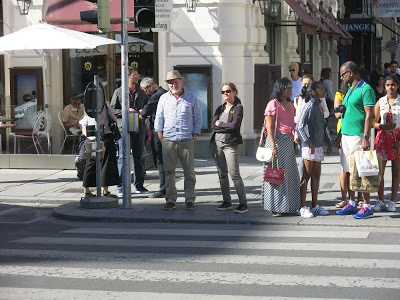
The cagey Professor, trying to chat up My Heart.

I will leave you with this, just because. Lots of possibilities here.
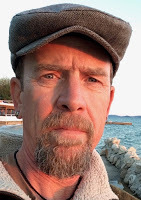
An ex-resident of Seattle, Marco Etheridge lives and writes in Vienna, Austria. When he isn’t creating great fiction or being a good Hausmann, he explores the world with his lovely wife. If the sun is shining too brightly, or the birds are too chipper, Marco studies German grammar to create a suitably dark mood for creativity. He is the author of two novels, The Best Dark Rain and Blood Rust Chains. Marco’s current projects include a children’s book and the first draft of his third novel, a political satire/thriller set in Europe.
Marco Etheridge Fiction
Published on July 20, 2018 23:21



